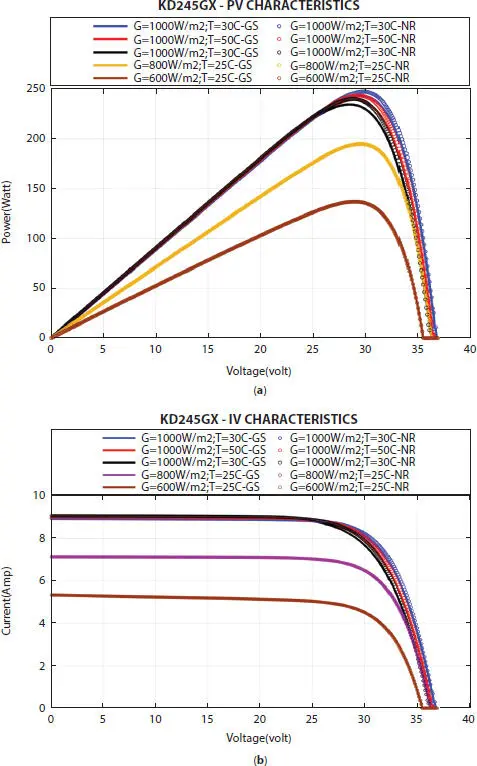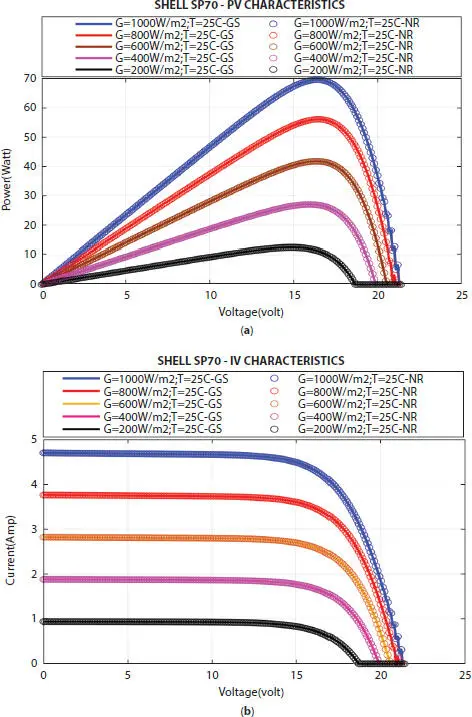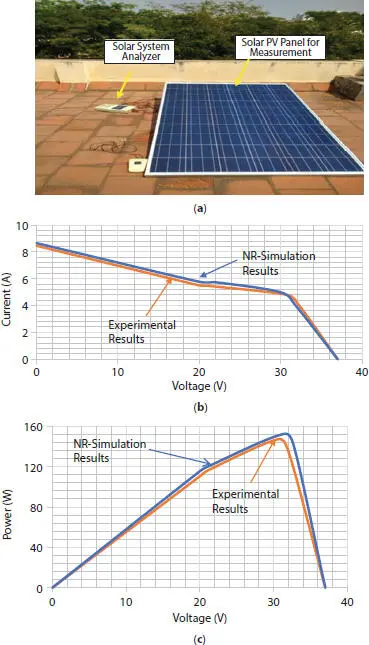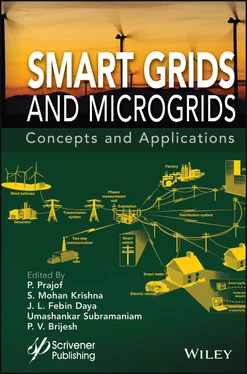1 ...6 7 8 10 11 12 ...17 
Figure 1.4 Simulation results of KD245GX (a) P-V characteristics (b) I-V characteristics.

Figure 1.5 Simulation results of SHELL SP70 (a) P-V characteristics (b) I-V characteristics.
Table 1.6 Experimental data observed from the HST60FXXXP PV module.
| T (°C) |
G (W/m2) |
A |
Rse |
Rsh |
ILG |
Isat |
Vmpp |
Impp |
Pmpp |
| 36.9 |
929 |
0.8055 |
0.2716 |
7.09E4 |
7.9896 |
1.62E-11 |
30.001 |
4.7991 |
147.33 |

Figure 1.6 (a) Experimental set up of HST60FXXXP 250 W SPV panel (b) Simulated and experimental I-V curves (c) Simulated and experimental P-V curves.
Table 1.7 I-V and P-V data obtained from NR simulation and experimental set up of HST60FXXXP 250 W SPV Panel.
| NR- simulation results |
Experimental results |
| V(V) |
I(A) |
P(W) |
V(V) |
I(A) |
P(W) |
| 37 |
0 |
0 |
37 |
0 |
0 |
| 33 |
4.0363 |
133.2 |
32.2 |
4.0559 |
130.6 |
| 31.5 |
4.8432 |
152.56 |
30.001 |
4.7991 |
147.33 |
| 21.2 |
5.6833 |
120.5 |
21 |
5.5242 |
116.01 |
| 20 |
5.775 |
115.5 |
19.8 |
5.5278 |
109.45 |
| 0 |
8.65 |
0 |
0 |
8.45 |
0 |
Table 1.8 Comparative analysis on voltage and current at MPP for Shell SP70 panel with T=25°C.
|
Sandia model [22] |
Based on equivalent parameters [18] |
ANFIS [18] |
GS [15] |
NR |
| G (W/m2) |
Vmpp(V) |
Impp(A) |
Vmpp(V) |
Impp(A) |
Vmpp(V) |
Impp(A) |
Vmpp(V) |
Impp(A) |
Vmpp(V) |
Impp(A) |
| 1000 |
16.5 |
4.24 |
16.37 |
4.25 |
16.29 |
4.27 |
16.51 |
4.25 |
16.4975 |
4.2498 |
| 800 |
16.56 |
3.42 |
16.43 |
3.39 |
16.38 |
3.41 |
16.59 |
3.41 |
16.5814 |
3.4061 |
| 600 |
16.55 |
2.57 |
16.41 |
2.53 |
16.39 |
2.54 |
16.49 |
2.55 |
16.4755 |
2.5542 |
| 400 |
16.35 |
1.72 |
16.24 |
1.66 |
16.26 |
1.67 |
16.12 |
1.7 |
16.0935 |
1.6979 |
| 200 |
15.87 |
0.87 |
15.66 |
0.79 |
15.73 |
0.81 |
15.18 |
0.84 |
15.1603 |
0.8415 |
Table 1.9 Comparative analysis of maximum power at MPP for Shell SP70 panel with T=25°C.
| G(W/m2) |
Sandia model [22] |
Based on actual equivalent parameters [18] |
ANFIS [18] |
GS [15] |
NR |
| 1000 |
69.96 |
69.5725 |
69.5583 |
70.16 |
70.1122 |
| 800 |
56.6352 |
55.6977 |
55.8558 |
56.52 |
56.4832 |
| 600 |
42.5335 |
41.5173 |
41.6306 |
42.11 |
42.0926 |
| 400 |
28.122 |
26.9584 |
27.1542 |
27.35 |
27.3231 |
| 200 |
13.8069 |
12.3714 |
12.7413 |
12.77 |
12.7591 |
In this chapter, the GS and NR methods were used to estimate the five unknown parameters of SDM of PV panel such as KD245GX, U5-80 and Shell SP70 under STCs. The results have shown better performance for the NR technique compared to GS method. Further, both the approaches were used to deduce the parameters of KD245GX and Shell SP70 PV panel under dynamic environmental conditions of varying irradiance and temperature. The unknown parameters like A, R se, R sh, I sat, and I LGare estimated for wide range of operating conditions and the result shows better convergence for both the techniques. However, the MPP obtained from NR technique is found to be more than the GS method under varying irradiance and temperature condition. In order to validate the feasibility of presented NR approach a HST60FXXXP, 250 W panel was experimentally tested under dynamic environmental conditions. The results of I-V and P-V characteristics obtained using estimated parameters from NR technique through simulation has good agreement with the experimental result. Thus, the results have shown that the maximum power output from the panel decreases as the solar irradiance decreases due to increase in shunt resistance of the panel.
1. Vinayagam, A., Aziz, A., Balasubramaniyam, P. M., Chandran, J., Veerasamy, V., & Gargoom, A. (2019). “Harmonics assessment and mitigation in a photovoltaic integrated network”. Sustainable Energy, Grids and Networks , 20 , 100264.
2. Abbassi, R., Abbassi, A., Jemli, M., & Chebbi, S. (2018). “Identification of unknown parameters of solar cell models: A comprehensive overview of available approaches”. Renewable and Sustainable Energy Reviews , 90 , 453-474.
3. Biswas, P. P., Suganthan, P. N., Wu, G., & Amaratunga, G. A. (2019). “Parameter estimation of solar cells using datasheet information with the application of an adaptive differential evolution algorithm”. Renewable Energy , 132 , 425-438.
4. Ishaque, K., & Salam, Z. (2011). “An improved modeling method to determine the model parameters of photovoltaic (PV) modules using differential evolution (DE)”. Solar energy , 85 (9), 2349-2359.
5. Sahu, H. S., & Nayak, S. K. (2016). “Numerical approach to estimate the maximum power point of a photovoltaic array”. IET Generation, Transmission & Distribution , 10 (11), 2670-2680.
6. Ishaque, K., Salam, Z., Amjad, M., & Mekhilef, S. (2012). “An improved particle swarm optimization (PSO)–based MPPT for PV with reduced steady-state oscillation”. IEEE transactions on Power Electronics , 27 (8), 3627-3638.
7. Kumar, C., Raj, T. D., Premkumar, M., & Raj, T. D. (2020). “A new stochastic slime mould optimization algorithm for the estimation of solar photovoltaic cell parameters”. Optik , 223 , 165277.
8. Abdulrazzaq, A. K., Bognár, G., & Plesz, B. (2020). “Evaluation of different methods for solar cells/modules parameters extraction”. Solar Energy , 196 , 183-195.
Читать дальше















